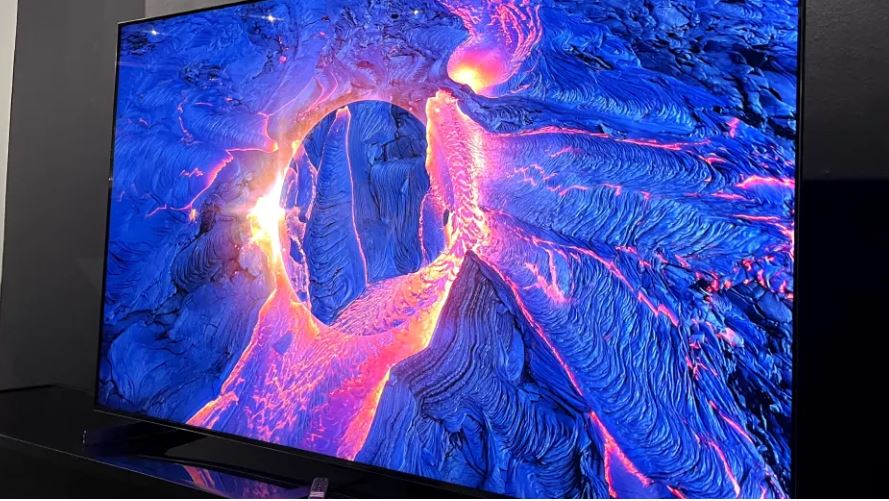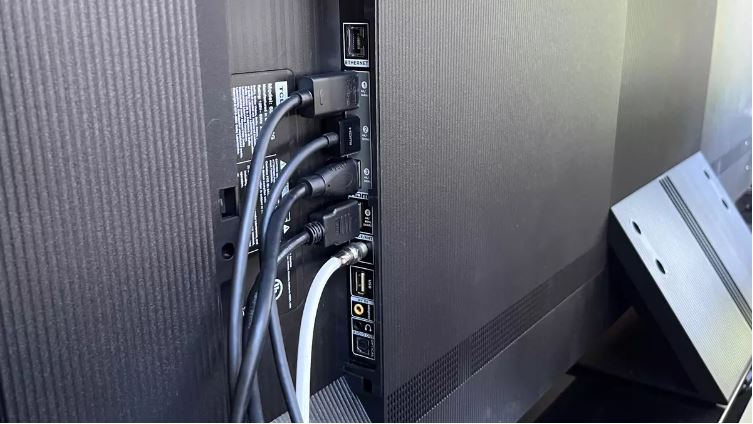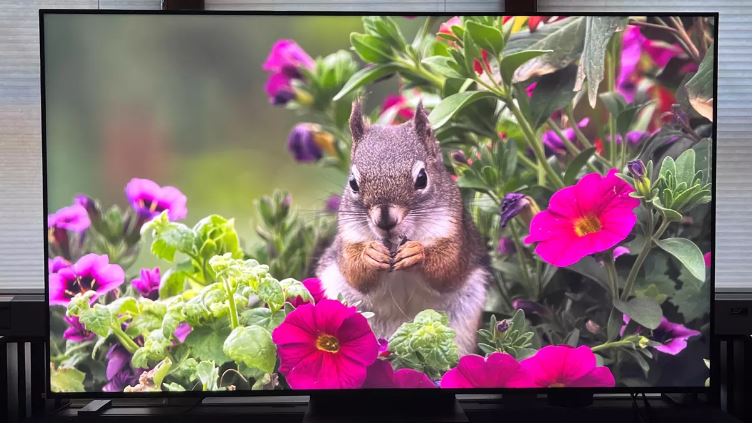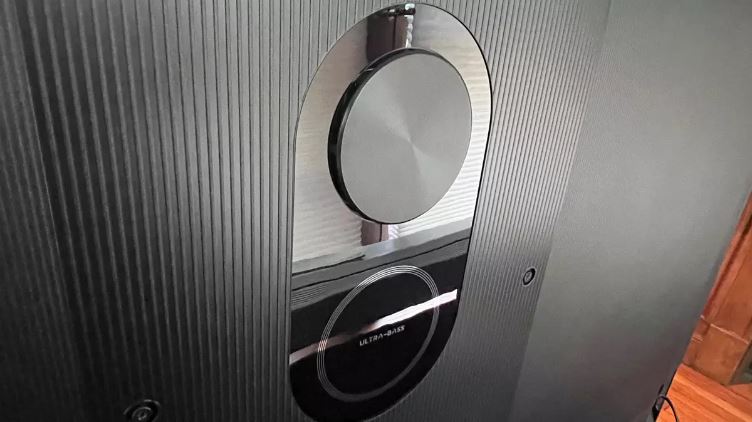TCL’s top mini-LED TV is a bright big-screen value

Image: © Future
TCL QM8 TV: TWO-MINUTE REVIEW
TCL’s QM8 Class 4K TVs are the company’s only mini-LED TVs for 2023, but the company clearly wanted to offer something special for its flagship line. What’s special about the new QM8 Class sets is they are being offered in screen sizes up to a staggering 98 inches. Peak light output is also higher than earlier TCL mini-LED TVs, a factor that in many ways lets them compete with similarly featured but higher-cost models from the big-name brands.
Mini-LED TVs regularly occupy slots in our list of the best 4K TVs, and not just because of their powerful brightness, but because top models also offer refined local dimming, a feature that, when well implemented, can deliver the deep and uniform blacks characteristic of the best OLED TVs. The QM8 Class does a great job on the local dimming front, and its powerful picture processing upscales regular HD images in a clean manner, while also excelling on motion handling and noise reduction.
The QM8 TVs are a great option for gaming with next-gen consoles. Dual HDMI 2.1 ports support 4K 120Hz input while a Game Accelerator feature allows for up to 240Hz VRR gaming at 1080p resolution. TCL’s top TV also has a Game Master mode that reduces input lag significantly when active and provides a transparent game bar menu option with gaming-specific settings.
TCL took care to make its flagship QM8 TVs look good. The sets have a slim, bezel-free design, with a center-mounted stand that’s height adjustable. TCL’s backlit remote features a built-in mic for voice commands, and there’s also a mic built into the TV itself for hands-free commands. The sets use Google TV as the smart interface, but also work with Alexa and Apple’s HomeKit.
A built-in 2.1 speaker system lets the QM8 Class TV provide clear-sounding dialogue and play reasonably loud with distortion, though you’ll benefit from pairing it with the best soundbars. If you do choose to depend on the TV’s built-in audio, there’s support for Dolby Atmos and DTS Virtual: X processing, along with a range of settings to enhance sound quality.
Value is a big factor with TCL, and the QM8 Class certainly delivers on that front. You’d have to pay quite a bit more to get better performance from a mini-LED TV than what you’re getting here. And while it’s great that there’s a 98-inch size option, a 55-inch screen would have also been a welcome addition for those with more limited living space and budget.
TCL QM8 TV REVIEW: SPECS


Back panel inputs include four side-mounted HDMI 2.1 ports (two HDMI 2.1 and one with eARC), an optical digital output, and an antenna connection for the TV's ATSC 1.0 tuner. (Image credit: Future)
TCL QM8 TV REVIEW: FEATURES
-
Mini-LED backlight with local dimming
-
Dolby Vision IQ and HDR10+ high dynamic range
-
4K 120Hz support with 240Hz VRR for gaming
TCL’s QM8 class QLED TVs feature a mini-LED backlight with full array local dimming – 1080 zones on the 65-inch model I tested. It supports the Dolby Vision IQ, HDR10+, and HLG high dynamic range formats, and uses the company’s APIQ Gen 3 processor for upscaling and other video processing functions. QM8 TVs also have an anti-glare screen coating to improve viewing conditions in bright rooms.
Google TV is the smart TV interface of choice here, and the set has a built-in mic that can be enabled for hands-free voice commands. TCL’s remote control also features a built-in mic that can be manually activated if you don’t want your TV always listening to you. Along with Google Assistant, the QM8 works with Alexa and Apple HomeKit, and it supports wireless streaming via Chromecast built-in and AirPlay 2.
The QM8 has a native 120Hz display and its dual HDMI 2.1 ports support 4K 120Hz input from next-gen game consoles. A Game Accelerator feature allows for up to 240Hz VRR gaming at 1080p resolution and FreeSync Premium Pro is also supported.
TCL’s TV offers both Dolby Atmos and DTS Virtual: X processing for its built-in 2 x 10 watts speaker system, with another 20 watts for a subwoofer. One of its HDMI outputs supports eARC for connecting to an external soundbar, and you can also wirelessly output audio via Bluetooth for private listening with headphones.
Features Score: 4.5/5

The QM8's picture is characterized by rich color and strong contrast. (Image credit: Future)
TCL QM8 TV REVIEW: PICTURE QUALITY
-
High peak brightness
-
Deep blacks with detailed shadows
-
Some backlight blooming
The 65-inch TCL QM8 Class TV I reviewed delivered notably higher peak brightness with HDR sources than the 85-inch version I had performed a hands-on test of earlier this year. While that model managed to hit 1805 nits in its default Movie mode, peak brightness on the 65-incher measured an astonishing 2321 nits on a 10% white window test pattern in the same picture mode, which is the most accurate of the TV’s presets. A white pattern covering 100% of the TV’s screen measured 721 nits, which is similarly impressive. A software update TCL issued in late June 2023 is presumably responsible for the QM8’s performance boost, so make sure you have it downloaded.
With the TV’s Local Contrast (local dimming) set to High, it manages to display black levels that are basically unmeasurable, resulting in “infinite” contrast. Black uniformity when viewing high contrast images with bright highlights set against dark backgrounds was also very good, with only a minimal degree of light blooming effects. This mainly showed up on black letterbox bars in ultra-widescreen movies, so unless you watch lots of those, chances are you won’t even notice it.
The color balance in the TV’s Movie picture mode was mostly accurate. Delta E values averaged out to 4 (we typically look for these to dip below 3), with a high of 6.3. Measurements made with Portrait’s Calman color calibration software showed coverage of DCI-P3 (the color space used for mastering 4K Blu-rays and digital cinema releases) to be 97%, and BT.2020 to be 76.0%, both of which are excellent results.
The QM8’s anti-glare screen coating did a very good job of reducing the effect of overhead lights on its picture. Even shadowy areas in images looked solid black without any on-screen reflections. Like many other LCD TVs that use VA (Vertical Alignment) panels, both the TCL’s picture contrast and color saturation were reduced when viewing from far off-center seats.
Starting my viewing tests as usual with the demonstration section of the Spears & Munsil Ultra HD Benchmark disc, the QM8 did a great job of handling HDR images graded at a high brightness level. Colors looked suitably rich in the images of nature and shots with strong highlights such as a sunset or light reflecting off glass showed powerful contrast. A starfield test from the same disc showed no sign of blooming effects, though the black levels weren’t as deep as what you’d see from the top OLED TVs.
Watching a 4K Blu-ray of Shadow by Chinese director Zhang Yimou, the movie’s black-and-white images showed a wide range of fine gray tones. Blacks were impressively deep, and the white highlights had a nicely punchy quality. Detail was also excellent, with transparent fabrics in scenes that take place in the king’s chamber showing intricate layering.
Two other reference 4K Blu-rays, Dune and No Time to Die also showed off what the QM8 was capable of. In Dune, the orbs that float around in interior chambers looked intensely bright against the dark backgrounds. Difficult dim scenes with a fair amount of film grain were also well handled, with the image appearing noise-free.
In No Time to Die, a scene in Italy where Bond and Madeleine climb up a stairs at night while burning notes are let loose over the city showed similarly strong HDR contrast. And in a later scene where Bond walks across rugged hills as the camera tracks his progress, the TCL’s excellent motion handling ensured that images looked solid with only a limited amount of judder.
Picture quality score: 4.5/5

The QM8's built-in audio system benefits from a rear-mounted subwoofer. (Image credit: Future)
TrendForce 2022 Mini LED New Backlight Display Trend Analysis
Publication Dates: April 30 and October 31, 2022
Language: Traditional Chinese/English
Format: PDF
Number of Pages: The two publications will total 120–130 pages
If you would like to know more details , please contact:











